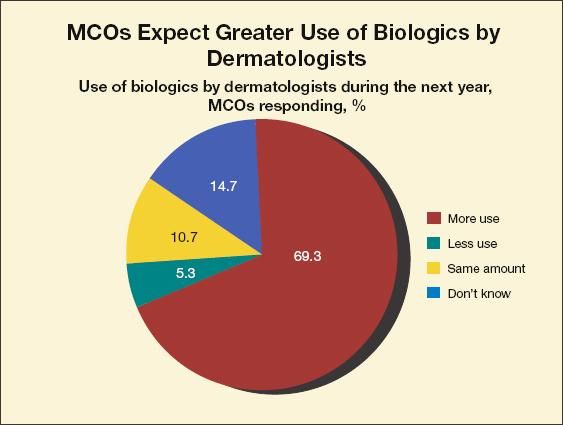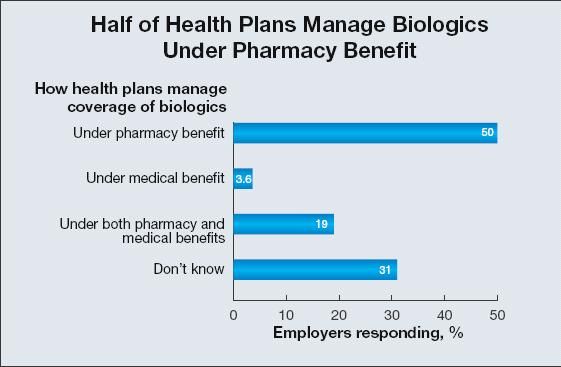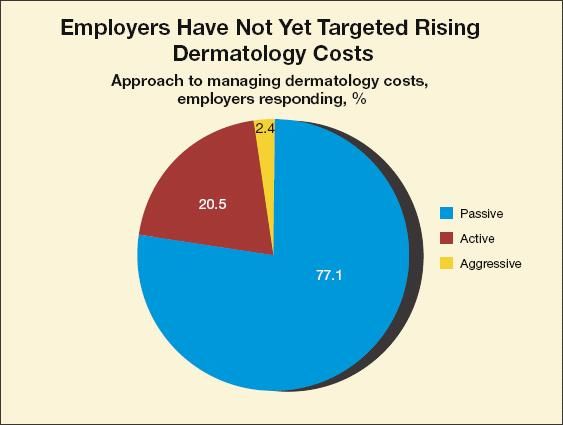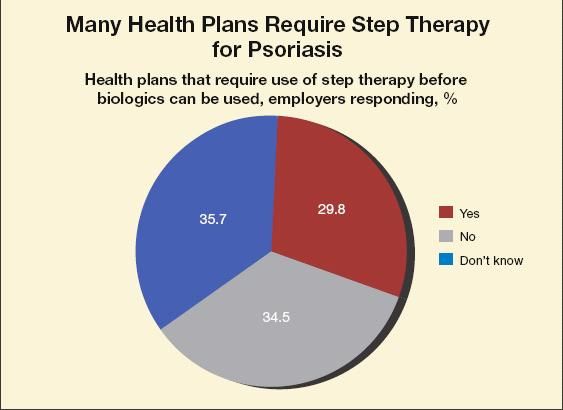- Clinical Technology
- Adult Immunization
- Hepatology
- Pediatric Immunization
- Screening
- Psychiatry
- Allergy
- Women's Health
- Cardiology
- Pediatrics
- Dermatology
- Endocrinology
- Pain Management
- Gastroenterology
- Infectious Disease
- Obesity Medicine
- Rheumatology
- Nephrology
- Neurology
- Pulmonology
Biologics Are Changing the Face of Psoriasis Treatment
As dermatologists' use of biologic drugs for psoriasis grows, MCOs must take an increasingly active role in managing the near-term utilization of these high-cost agents while also taking into account that some of the "payback" for these drugs comes in the form of long-term costs avoided. Meanwhile, physicians, insurers, and employers continue to wrestle with issues such as step-down dosing; step therapy; patient-administration versus physician-administration; and whether biologic drugs should be covered under a plan's pharmacy benefit, medical benefit, or some combination. (Drug Benefit Trends. 2008;20:143-147).
As dermatologists' use of biologic drugs for psoriasis grows, MCOs must take an increasingly active role in managing the near-term utilization of these high-cost agents while also taking into account that some of the "payback" for these drugs comes in the form of long-term costs avoided. Meanwhile, physicians, insurers, and employers continue to wrestle with issues such as step-down dosing; step therapy; patient-administration versus physician-administration; and whether biologic drugs should be covered under a plan's pharmacy benefit, medical benefit, or some combination. (Drug Benefit Trends. 2008;20:143-147)
More dermatologists are prescribing biologics for their patients who have psoriasis. Some biologics are injectables that can be administered at home and are typically covered under the health plan's pharmacy benefit. Other biologics need to be infused and are generally administered in a physician's office and reimbursed through the plan's medical benefit. Increasingly, though, distribution is through specialty pharmacy vendors.
"Clearly, the majority of dermatologists have changed their prescribing behavior regarding biologic drugs for psoriasis," said Alan B. Fleischer Jr, MD, professor and chair of dermatology, Wake Forest University School of Medicine in Winston-Salem, NC. With more dermatologists prescribing these medications-and more patients taking them-per member per month costs for MCOs are rising, he noted.
The 2007 edition of the Galderma Quality Report for Dermatology & Managed Care found that 67% of dermatologists surveyed prescribed more biologic therapies for psoriasis during the past year than previously. Nearly 70% of MCOs surveyed anticipate that dermatologists will use more biologic treatments in the future (Figure 1).

Figure 1. Most MCOs see dermatologists
increasing their use of biologics.
Half of the employers surveyed in the Galderma report said their health plans manage biologics under the pharmacy benefit. Just 3.6% of employers said their plans provide coverage of biologics under the medical benefit, while 19% said their plans reimburse under both the pharmacy and medical benefits (Figure 2).

Figure 2. Most self-injectables are reimbursed
under the pharmacy benefit.
Two of the biologics approved for psoriasis-Remicade (infliximab, Centocor) and Amevive (alefacept, Astellas)-must be infused or injected in a physician's office. "Coverage for these 2 agents tends to be under the medical benefit while coverage of home-injected products is generally managed under the pharmacy benefit," said Fleischer.
Nationally, infused products managed under the medical benefit account for approximately 20% of biologic drug use in dermatology, said Terry Killilea, PharmD, president of Medical Cost Solutions, LLC, Boise, Idaho. Injectable biologics managed under the pharmacy benefit, including Enbrel (etanercept, Wyeth/Amgen), Raptiva (efalizumab, Genentech), and Humira (adalimumab, Abbott), account for the other 75% to 80%, he said.
However, some plans have shifted coverage of injectable biologics to the medical benefit because this allows plans to charge coinsurance percentages of 20% or more, said Killilea. "The problem is that members reach their out-of-pocket maximum-usually $3000 to $5000 per year-rather quickly. And then there is no cost sharing." For example, he explained, a person with psoriasis who pays 20% coinsurance on a drug that costs $3000 monthly will pay $600 monthly, reaching $3000 in total out-of-pocket expenditures in 5 months.
Most plans, however, prefer to cover injectable biologics under the pharmacy benefit. The current trend in plan design is to shift biologics from the medical benefit to the pharmacy benefit. Employers believe that, in general, the pharmacy side offers better pricing, and that patients receive good follow-up care from specialty vendors.
With injectable biologics covered under the pharmacy benefit using a 4-tier benefit design with 20% coinsurance on specialty drugs, for example, "the health plan will get that 20% throughout the year, because an out-of-pocket maximum is not common for pharmacy benefits," Killilea explained. The Galderma report reveals that the proportion of health plans using 4-tier pharmacy benefit designs has grown more than 20% over the past 2 years. However, Killilea noted, "I am not sure a fourth tier is always necessary. If a health plan has a percentage coinsurance on brand-name medications, such as 20% to 25% (without a maximum), that can be used instead."
Employers Overwhelmed
"Employers are struggling with the rising cost of the pharmacy benefit. The primary reasons are an increased number of biologics that are available for dermatology and other indications and their increased use," said Jeff Martin, PharmD, director of clinical programs at Innoviant, a Wausau, Wisconsin-based PBM. Although some employers have added fourth tiers to their pharmacy benefit with coinsurance amounts as high as 30% to 40%, he said, "many are hesitant to do so because an average monthly cost of $1500 to $2000 results in coinsurance amounts of $500 to $800, which is prohibitive for many individuals. But in some cases, employers have decided they just cannot afford to be responsible for those costs. I believe this trend will continue."
Presently, said Martin, "the biggest issue employers are dealing with is trying to understand whether they should require that biologics be available only through a specialty pharmacy benefit." Innoviant's program requires members to fill specialty prescriptions through a specialty vendor rather than a retail pharmacy. Martin said that the program provides employers with lower product acquisition costs and access to specialty vendors' disease management programs. "Specialty vendors can help us manage specific cases and make sure patients are adhering to their medication regimens," he said.
In addition, Martin noted that some employer groups are considering requiring physicians to purchase certain infusion products through specialty vendors. "Having those products drop-shipped directly to physicians' offices prevents the physicians from buying them, marking them up significantly, and passing on the higher cost to the health plan and patient," he explained. Although this approach currently is being used by a small number of payers, he predicted that more employers will follow this model.
How fast "depends on physician acceptance. Some physicians do not like it because it cuts out a revenue stream, but others would prefer to get out of the business of purchasing products and dealing with inventories and carrying costs," said Martin.
Broader coverage of light therapies also could help MCOs dampen demand for biologic psoriasis medications, said Fleischer. He said he was surprised by the report finding that only 21% of employers surveyed indicated that their health plans cover light therapies such as psoralen and UV-A light therapy.
"Light treatments are the most cost-effective treatments for patients with inflammatory skin disease," said Fleischer. "Non-coverage suggests to me that some insurers do not understand the process of care." He proposed that it would be to the advantage of plans to eliminate copayments for patients receiving light therapies. With 3 or more visits per week typically prescribed for light therapy, "the copays become oppressive and deter patients from having the least costly treatment overall," said Fleischer. "Whereas if patients are charged one $40 monthly copay for $2500 worth of etanercept, for example, that is a far better deal for the patient-but not for the plan."
More than three quarters (77%) of employers characterized their approach to managing dermatology costs as passive (Figure 3). "Even with biologics," said Fleischer, "there does not seem to be an enormous effort to control costs." Whether employers will take a more aggressive approach depends on how quickly dermatology-related costs escalate, he predicted.

Figure 3. Rising costs may push employers to
take a more active role in managing dermatology costs.
Already, Killilea noted, "dermatology is one of the fastest-growing areas of biopharmaceutical use." The risk of inadequately managing this category is significant, he said. "If psoriasis alone incurs a large amount of biologic use," he explains, "plan sponsors will experience a large increase in costs, possibly with no improved outcome in some cases."
In the Galderma report, 43% of employers said their health plans' formularies included biologic medications, while 13% of employers said biologics were not included (44% did not know). Regarding use of step therapy before starting biologics, 29.8% of respondents said their plans required that patients start treatment with a less expensive medication first (Figure 4). "If dermatological costs increase rapidly," Fleischer said, "we could expect that more of the plans will require some kind of step therapy."

Figure 4. Rising costs could lead to more plans requiring step therapy
before covering biologic therapy.
Of MCOs surveyed, 81% said they required step therapy with nonbiologic agents for the treatment of psoriasis before approving biologics.
An argument could be made that the most cost-effective therapy is the one that gets employees back to work the quickest. "The employer perspective on this should be that employees whose psoriasis is under good control are more productive. They do not need to take nearly as much time off to care for their skin, and they experience less physical discomfort," said Alexa Boer Kimball, MD, MPH, associate professor of dermatology, Harvard Medical School, Boston, and director of the Clinical Unit for Research Trials in Skin at Massachusetts General Hospital and Brigham and Women's Hospital.
Although researchers are just beginning to look into health resource utilization information regarding biologic treatments for psoriasis, Kimball added, "all of it points to the same conclusion-with good treatment, patients can function much better in all dimensions of their lives, including work."
Clinical Experience
Because clinicians have more experience with etanercept, which was approved for psoriasis in 2004, "we are starting to see study results regarding its use in combination therapy and special situations," said Kimball. For example, one pediatric study shows that 57% of etanercept-treated patients achieved symptom relief, reaching Psoriasis Area and Severity Index (PASI) 75 at 12 weeks, versus 11% of placebo-treated patients.1 In a 12-week open label study of etanercept and narrow-band UV-B therapy, 85% achieved a response of PASI 75 or higher.2
"We have learned a huge amount about how this drug can be used in terms of short-, medium-, and long-term treatment and optimal dosing changes for various clinical situations," said Kimball.
Etanercept originally was approved with step-down dosing. "It is important to understand the history of that dosing regimen," said Kimball. "Two large studies were conducted simultaneously: one in which patients were administered 50 mg twice a week, and the other 50 mg twice a week, but then 'stepping down' after 3 months to 50 mg once a week," said Kimball. Subsequently, patients who received 50 mg twice weekly were followed for as long as 2 years, which helped establish etanercept's safety and efficacy at that dosage, added Kimball. Another important finding was that heavier patients may not do as well as lower-weight patients.3
Etanercept's original step-down studies show that in comparing responses of 12 and 24 weeks, "the proportion of patients maintaining a PASI 75 response is not all that different-that is likely why the FDA granted approval for the step-down dose," said Kimball. Specifically, the proportion of patients achieving PASI 75 at 12 weeks was 49%, versus 54% who achieved this response level at 24 weeks, or 12 weeks after dosing was reduced from 100 mg weekly to 50 mg weekly.4 The corresponding figures for patients receiving continuous 50 mg doses twice weekly were 49% and 59%,5 although one cannot compare these two studies directly, said Kimball. "The aggregate step-down data can overshadow the fact that a small proportion of patients who step down lose response," she said. So while the absolute number of persons who get better with step-down dosing is about the same as the number who get worse, "some of the people who get worse tend to get quite a bit worse."6
For heavier patients-or those for whom continuous higher doses help maintain a good response- sticking with the higher dose may be extremely important. "There are clearly some patients who will not be able to achieve a good response with step-down therapy and may need to be maintained at 50 mg twice weekly," said Kimball. While the results of the 2-year follow-up studies raise no new safety concerns regarding this regimen, health plans' willingness to pay for continuous doses at 50 mg twice weekly varies regionally, she noted.
"That's the trouble with the biologics that are self-injected by the patient. There is a fixed dose schedule, and we cannot adjust it," explained Jack Waxman, MD, a rheumatologist in private practice at Northern California Medical Associates, Santa Rosa, which currently provides infusion services for 10 patients with psoriasis. In contrast, infliximab dosing depends on patients' body weight. "Heavy patients tend to do better with the higher dose that is based on body weight than with a fixed dose of etanercept," he said.
Infusion Concerns
Despite dermatologists' plans to increase their reliance on biologics, "we are not seeing that overwhelming response from dermatologists when it comes to referring patients for infliximab infusions," said Waxman. "There are probably dozens of patients locally who need such therapy but are not receiving it."
Waxman said some dermatologists have expressed worries that infliximab will cause lymphomas or other cancers. "They think of it as a standard immunosuppressive agent like methotrexate." Waxman and his colleagues tried to defuse these fears by pointing out that they have not seen any lymphoma in their patients, whom he said are responding well to infliximab. Nor have they seen any cases of lymphoma resulting from use of tumor necrosis factor (TNF) antagonists in the literature, he said. By and large, he said, local dermatologists seem to prefer the use of injectable TNF blockers, perhaps because they find it is somewhat cumbersome to refer patients to another practice for infusion treatments.
Waxman noted that the use of infliximab in his patients has resulted in their psoriasis and psoriatic arthritis (PSA) being virtually eradicated. Overall, 20% to 40% of psoriasis patients-usually the most severe cases-also have PSA, he noted. "We've treated some of the worst cases and gotten such dramatic results with infliximab," he said. Severe scalp psoriasis in one patient who had it for 20 years cleared after just a few months' treatment with infliximab and remained clear with maintenance treatments every 8 weeks, Waxman reported.
"However, use of infliximab for psoriasis is costly for plans," said Waxman. "On the other hand, if patients don't need repeat phototherapy or other therapies-and don't require surgery down the road for joints that become eroded and damaged-use of infliximab may be cost-effective for plans over the long term."
Some mild cases of psoriasis respond well to sulfasalazine, said Waxman. Patients with more severe cases may also require methotrexate and a topical cream. Even at higher doses of methotrexate, per-patient treatment costs remain in the hundreds versus thousands of dollars, Waxman noted. "It is only that severe subgroup-maybe 30% to 40% of patients-who need infliximab or a TNF inhibitor for psoriasis and PSA."
Pipeline Prospects
Two interleukin (IL)-12 and IL-23 inhibitors under development (ABT- 874, Abbott; ustekinumab, Centocor) may soon gain FDA approval, said Fleischer. In clinical testing, he said, "they appear to be highly effective, and operate through different mechanisms than available biologics."
Etanercept, adalimumab, and infliximab all work by inhibiting the TNF-α system, said Fleischer. The 2 drugs under development target IL-12 and IL-23, naturally occurring proteins that are believed to play a role in immune-mediated inflammatory disorders. Because ustekinumab is delivered by subcutaneous injection that patients can self-administer at home, it might further increase insurers' reliance on the pharmaceutical benefit to manage biologic drugs, added Fleischer. ABT-874 also is injectable.
Centocor submitted data on ustekinumab from 2 large phase 3 trials to the FDA in December 2007. ABT-874 entered phase 3 psoriasis studies in late 2007. Also for psoriasis, said Fleischer, at least 2 vitamin D analogues are far along in development and are similar to Dovonex (calcipotriene, Warner Chilcott).
"We've heard that Orencia (abatacept, Bristol-Myers Squibb), approved for rheumatoid arthritis, is being studied in PSA. We're hoping to see an approval for that indication in the near future," added Waxman.
For acne, Fleischer said, "we may see Aczone (dapsone gel, QLT) marketed in the near future (it was approved 2 years ago)." Galderma also is developing a product that combines Differin (adapalene) with benzoyl peroxide, he said.
Another dermatological trend involves treatment of actinic keratoses (AKs), said Fleischer. More than half of dermatologists surveyed expected to use more pharmacological treatments for this condition in the coming year. "Increasingly," he said, "there's an emphasis on treating not just individual lesions, but the entire field of damage. These kinds of treatments are best done with pharmacological agents." Accordingly, Fleischer said MCOs might expect to see increasing use of Aldara (imiquimod, Graceway), Carac (fluorouracil, Sanofi-Aventis), and Efudex (5-fluorouracil, Valeant). Furthermore, he said it might prove less costly for health plans to treat AKs pharmacologically rather than with devices that target individual lesions.
Conclusion
Clearly, dermatologists are expected to increase their prescribing of biologics to treat patients with serious skin conditions. It is up to plans, PBMs, and specialty pharmacies to manage access in such a way that patients who require biologics can receive them while also containing costs as much as possible.
References:
References
- 1. Paller AS, Siegfried E, Langley R, Gottlieb A. A 12-week phase 3 study of efficacy and safety of etanercept therapy in children and adolescents with moderate to severe plaque psoriasis. Poster 2783 presented at: the American Academy of Dermatology (AAD) 65th Annual Meeting; February 2-6, 2007; Washington, DC.
- 2. Kircik L, Elmets C, Menter A, Koo J. Utilization of narrow-band UVB light therapy and etanercept for the treatment of psoriasis (UNITE): characteristics of PASI responders. Poster 18 presented at: the AAD 65th Annual Meeting; February 2-6, 2007; Washington, DC.
- 3. Strober B, Gottlieb A, Leonardi C, Papp K. Levels of response of psoriasis patients with different baseline characteristics treated with etanercept. Poster 2890 presented at: the AAD 64th Annual Meeting; March 3-7, 2006; San Francisco.
- 4. Papp KA, Tyring S, Lahfa M, et al. A global phase III randomized controlled trial of etanercept in psoriasis: safety, efficacy, and effect of dose reduction. Br J Dermatol. 2005;152:1304-1312.
- 5. Leonardi CL, Powers JL, Matheson RT, et al. Etanercept as monotherapy in patients with psoriasis. N Engl J Med. 2003;349:2014-2022.
- 6. Leonardi CL, Boh E, Langley R, Krueger G. Assessment of response variability in patients treated with step-down etanercept therapy over 48 weeks. Poster 2861 presented at: the AAD 64th Annual Meeting; March 3-7, 2006; San Francisco.
